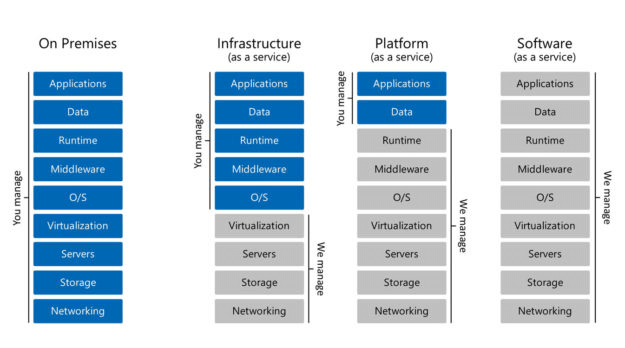What is Infrastructure-as-a-Service (IaaS)?
Infrastructure as a service, or IaaS, is a cloud solution that involves transferring a company’s internal computing resources from a traditional on-premise data center to servers that are hosted by a 3rd party and connected via the Internet. This means all the heavy lifting that goes into keeping a business’s IT up and running, such as operating data centers, networks, servers, storage etc., is performed by a cloud provider, all while maintaining its IT capabilities. One of the major benefits of cloud IaaS is that it can optimize the cloud environment for maximum efficiency with little risk, which most other pillars cannot do. It also offers flexible and scalable resource usage that helps in managing data-intensive workloads and high traffic volume across every level of the enterprise in a more optimal fashion than on-premises environments.
The way Cloud IaaS works is the cloud provider owns and operates the computational assets and equipment and you essentially rent them out based on your scheduled needs. In doing so, you can reduce reliability on data centers and IT personnel and consume IT resources as you need them. By replacing capital expenditures with this pay-as-you-go operational expense model, you can optimize spending and redirect in-house focus away from cumbersome IT maintenance to valuable IT performance enhancements that lead to agility and innovation.
Types of IaaS
There are three different types of Cloud Computing – Public, Private and Hybrid. If an organization is engaging in the Private Cloud, it means their computing resources are isolated and delivered via a secure private network, hosted in either an on-premises environment or a 3rd party vendor’s off-site location [in the discussion of cloud, they are hosted by a 3rd party]. The primary technical difference between Public Cloud and Private Cloud Hosting is that Private Cloud Hosting offers clients a dedicated and secure environment that cannot be accessed by other customers. Because you have the option to select Public or Private cloud (or a combination of both – Hybrid Cloud), Cloud IaaS is not inherently a Public Cloud solution, but instead, it is a personal choice and discretionary detail of its application within your business. If you are currently in a fully on-premise environment, your Cloud IaaS migration will require you to outsource a portion or all of your infrastructure from a hosting provider, in which case, you will have to select between a Public, Private or Hybrid hosting solution.
On-Premise vs IaaS vs PaaS vs SaaS

Business Benefits of Infrastructure as a Service
Cost Savings
Whether to improve the operational performance or foster capabilities for future growth, the investment in cloud IaaS must be financially viable. The strong financial incentive advantage that cloud IaaS offers makes it financially viable and also saves lot of costs.
IaaS replaces your on-premises data centers with a service that lets you provision infrastructure resources based on monthly needs. Since these investments can have a lifespan of 3-5 years, you’re forced to use these high-maintenance resources till their end of life. Unless, you want to forfeit the investment to pursue alternative measures, which would amount to thousands of dollars wasted.
For these reasons, the strict obligations you have with on-premise resources is not good for business longevity. The millions invested in the on-premise infrastructure forces companies reschedule spending on other value adding departments. This inability to invest in other areas might effect the overall operational efficiency and customer experience.
Maintenance and Scalability
Among the long term benefits of IaaS cloud computing, maintenance and scalability also holds high. By deploying Cloud Infrastructure, you’re replacing the on-premise environment with a service that offers monthly pricing, faster responsive, scalability and low maintenance.
Beyond the initial investment, your on-premise environment requires investment in human resources for data center management. Adding rent to this cost makes keeping the real estate in your possession and running it expensive. Also, Scaling your on-premise environment requires both financial and operational excellence to ensure no disruptions.
Business Continuity
On-premise data centers require yearly-recurring system implementations and upgrades. The reason these are challenging is not just the frequency, but also the impact they have on business continuity. These updates are highly disruptive to the business, taking weeks, even months, to complete. Productivity across the company might suffer as it has to operate at less than maximum capacity until the implementation/upgrade finalizes. Especially, if your business model is data-intensive and relies on smooth technological flow. One of the additional benefits of cloud IaaS is that your provider will keep your infrastructure running on the latest installations. They also expedite the upgrade process to keep you up to date and running quicker, saving you additional time as well.
Disaster Recovery
Another drawback of on-premise is disaster recovery i.e. the cost of putting out fires. Disaster recovery is stressful in terms of efforts and the cost of remediating damages can dive deep into the budget. For this reason, many companies conduct pre-emptive maintenance i.e. procedural behaviors that check system health on an ongoing basis. Yet, even with these in place, disaster still strikes, and the business still suffers not just financially, but also operationally. Also, the amount of time invested in regulatory maintenance can be utilized in other important tasks.
IaaS providers such as Oracle Cloud and Microsoft Azure have excelled in disaster recovery process. Streamlining the process is allowing them to offer cost-effective, flexible and low maintenance infrastructure as a service.
Improved Customer Experience
Not just the huge cost reductions and more financial freedom, IaaS also increases the productivity of key enterprise business drivers. How?
Streamlined automation and advanced computing enables end-users complete their workloads with greater efficiency. This in turn leads to greater value for the customer when they interact with your company.
What is a key business driver? A key business driver is something that drives the financial and operational results of a company. These depends on the nature of your business.
Examples on How IaaS Enhances Key Business Drivers
Service Delivery: Service delivery demands unlimited network availability and excellent service. Keeping the system up and running required top class network that is durable and consistent. Also, to empower your employees to make the right decisions, they must have tools to tap into your wide customer database. Otherwise, any delay is evidence against your ability to deliver on your promise. In an on-premise environment, this threat lingers at all times and depends on your in house team’s ability to manage the environment.
Website: It could be that your website has very high traffic. This requires your infrastructure to support many visitors accessing the page using variety of devices from different locations. Failing to handle such loads can result in high bounce rate and low conversion rate. These in turn will dent the brand image and revenues. In an on-premise world, the task of enabling this growth becomes more and more difficult and with less guarantee.
IaaS helps you in reducing the threats to your key drivers. The enhanced IaaS computing technology enables businesses to operate at maximum efficiency i.e. with less delay, and greater precision, for the customer. Cloud Infrastructure integrates the servers and automates data exchange processes needed for the technology to run, creating streamlined processing and higher performance speed.
Scalability and Flexibility
Scalability of cloud IaaS service model helps you provision additional infrastructure resources to power and sustain growth as it is happening, not after. This flexibility and scalability offered by IaaS enables full adaptability to capitalize off opportunities and mitigate threats in the market.
Planning for IaaS Adoption
Small, mid and large-scale enterprise adoption of Cloud IaaS is still in its youth. For this reason, best practices to ensure successful adoption in order to optimize Business-IT alignment are still in development. In fact, the discussion of what constitutes a “successful IaaS adoption” rarely includes the criteria of ensuring proper alignment between business strategy and IT before migration. When plotting their Cloud IaaS migration, IT personnel are quick to rely on their preset skills to develop their unique strategy.
However, historical misalignment between their department and the long-term business strategy may exist, and if it persists across their future Cloud IaaS migration, IT will suffer a loss of relevancy and governance, and the business will experience inefficiency, extra cost and complexity, while missing out on the benefits of innovation and agility commonly afforded by the Cloud. IaaS adoption plan can be broken down into three parts.
1. Establishing Definitions
The term “Cloud” is used liberally throughout IT departments. However, it does not adequately reflect the wide array of options that businesses have in making use of Cloud IaaS services. The possibilities vary greatly, ranging from simple hosting, colocation and virtualization on demand, to entire development platforms and managed application environments. While it may seem obvious, the critical first step in defining the scope of your Cloud IaaS adoption is to gain consensus on the different approaches to cloud infrastructure and deciding on which approach will fit best within your organization. That way, you can avoid confusion and future misunderstandings regarding how Cloud IaaS will be incorporated within your business.
According to Gartner, the number one goal should be to enhance education regarding the varying qualities of the different types of cloud computing, including private cloud (internal and hosted), the public cloud, the community cloud and the hybrid cloud. By becoming familiar with the details of their distinctions, you certify your expertise in Cloud solutions and can make more informed decisions about how Cloud will be incorporated within your business. Then, by offering this education to those outside of the IT department, you can construct a more effective business case for Cloud IaaS, defend against objections and gain the trust of individuals in other departments who may be feeling unease about the upcoming changes. Enhance education in the interim so that you can improve your credibility and make decisions from a more informed market perspective.
Determine Benefits and Challenges
“The Cloud” and its long list of applications carries with it an equally long list of benefits and challenges that Cloud IaaS adoption may or may not invoke. Nonetheless, the likelihood of realizing the benefits and mitigating the challenges increases when the business case has been established and the advantages have been clearly communicated across the business. The goal is to create a balance between the quick wins, long term drivers and foreseeable challenges that may ensue across the journey of your Cloud IaaS adoption. According to Gartner, some business benefits that you may consider include faster time to impact business, lower barriers to experimentation, easier expansion (and contraction) and enabler of digital business (new business functions and models, new business ecosystems and partners).
It’s often misconstrued that Cloud IaaS adoption is a quick and easy way to secure short term cost reductions, but this is the number one reason NOT to migrate to IaaS. Some IT benefits you may see include improved security, improved visibility of IT usage cost, reduction in technical debt and improved access to IT innovation. Challenges, however, may include restrictions on cloud usage due to compliance requirements and expense management and capacity planning [just to name a few]. It may be that this determination of benefits and challenges will be realized over a greater time frame. However, this is critical to defining the scope of your Cloud IaaS adoption and ensuring successful Business-IT alignment.
Evaluate Cloud Service Options
Another step in defining the scope of your Cloud IaaS adoption project is selecting the type of cloud service provider(s). According to Gartner, there are 4 Cloud service options. These are based on an analysis of the projected benefits of your Cloud IaaS adoption and your company’s ability to manage the challenges associated with the migration. These 4 options include:
- High and clear benefit with low and manageable challenges
- High and clear benefit with high or unmanageable challenges
- Low or uncertain benefit with low and manageable challenges
- Low or uncertain benefit with high or unmanageable challenges
In the case where benefits are high and clear and challenges are low and manageable, embrace a Public Cloud solution. If benefits are high and clear but challenges are high or unmanageable, consider a Private Cloud solution. However, if benefits are low or uncertain and challenges are low and manageable, it may be best to engage in some experimentation to see if evidence unveils in favor of one approach. Yet, if benefits are low or uncertain and challenges are high or unmanageable, avoid a Cloud solution altogether until conditions in your environment change to better accommodate the Cloud.



